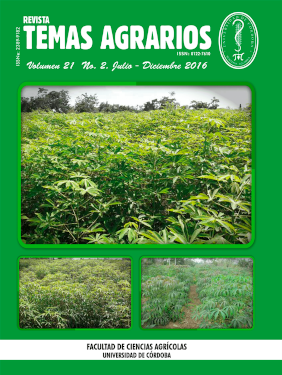Action of Bacillus thuringiensis (Berliner), as biological control of Spodoptera frugiperda (J.E. Smith). Lepidoptera: Noctuidae
Acción de cepas nativas de Bacillus thuringiensis (Berliner), como control biológico de Spodoptera frugiperda (J.E. Smith). Lepidoptera: Noctuidae

This work is licensed under a Creative Commons Attribution-NonCommercial 4.0 International License.
Show authors biography
This research evaluated the insecticidal activity of various native isolates of Bacillus thuringiensis against Spodoptera frugiperda, From Soils of Funza and Silvania (Cundinamarca) Tunja (Boyacá) in crops of beans, peas, maize and orange compared with a commercial witness HD1 (subsp. Kurstaki) against S. frugiperda. LC50 lethal concentration average was initially determined by the "probit" method, which was 5.88 E- 4 mg ai / ml of diet, strain HD1 with different doses (0.0; 6.8 E-2; 3.4E-2 ; 6.8E-3; 6.8E-4; 6.8E-5 6.8E-6 and ai mg / ml diet) in first instar larvae S. frugiperda. In addition to qualitative observations mortality was measured at 96 and 120 hours. Subsequently the determined median lethal concentration (LC50) with strain HD1 proceeded to use this concentration in each native B. thuringiensis isolates to be compared with the commercial control CL50. Design was completely randomized with 7 treatments (each with 25 first instar larvae) and 3 replications. For the second test determining promissory isolates of Bt, a completely randomized design with 11 treatments (each with 20 first instar larvae) and 3 replications was arranged. Results indicated that M3008 and M4001 native isolates have higher mortality averages, which were 75% and 71.65% respectively in first instar larvae in purified diet, compared with mortality LC50 of commercial control.
Article visits 1584 | PDF visits
Downloads
- Bravo, A., Sarabia, S., Lopez, L., Ontiveros, H., Abarca, C., Ortiz, A. and NuñezValdez, M. E. 1998. Characterization of cry genes in a Mexican Bacillus thuringiensis strain collection. Applied and Environmental Microbiology, 64(12), 4965-4972.
- Chak, K., Chao, D., Tseng, M., Kao, S., Tuan, S. and Feng, T. 1994. Determination and distribution of cry-type genes of Bacillus thuringiensis isolates from Taiwan. Applied and environmental microbiology, 60(7), 2415-2420.
- Del Rincón, M. Méndez L. e Ibarra, J. 2006. Caracterización de cepas nativas de Bacillus thuringiensis con actividad insecticida hacia el gusano cogollero del maíz Spodoptera frugiperda (lepidoptera: noctuidae).Folia Entomológica Mexicana 2006, 45 (2).
- Flórez, R. 2000.Efecto de la variedad de maíz sobre el desarrollo y susceptibilidad de larvas de Spodoptera frugiperda (Lepidoptera: Noctuidae) A Bacillus thuringiensis. México. 48 p.
- Gallegos, M. 1990. Implementación de la concentración mínima letal como método para cuantificar actividad de formulaciones de Bacillus thuringiensis. BIOTA, 15-23.
- Hernández M. 1988. Evaluation de la Toxicité de Bacillus thuringiensis sur Spodoptera frugiperda. Entomophaga. 33(2): 163-171.
- López-Edwards, M., Hernández-Mendoza, A., Pescador-Rubio, J., MolinaOchoa, R., Lezama-Gutiérrez, J, Hamm, J. and Wiseman, B. 1999. Biological differences between five populations of fall armyworm (Lepidoptera:Noctuidae) collected from corn México. Fla. Entomol. 82(2): 254-262.
- Quintero, L. (2015). Uso de baculovirus como alternativa de control biológico de" Spodptera frugiperda" en el cultivo del maíz: una revisión conceptual y de avances en su aplicación.
- Navon, A., Hare, J. and and Federici, B. 1993. Interactions among Heliothis virescens larvae. Cotton condensed tannin and the CrylA(c) - endotoxin of Bacillus thuringiensis. J. Chem. Ecol. 19: 2485-2499.
- Stapel, J., Waters, D., Ruberson, J. and Lewis, W. 1998. Development and behavior of Spodoptera exigua (Lepidoptera: Noctuidae) larvae in Choice Test with Food Substrares containg toxins of Bacillus thuringiensis. Biological control. 11(1): 29-37.
- Szewczyk, B., Hoyos, L., Paluszek, M., Skrzecz, I. and Lobo, M. 2006. Baculoviruses - re-emerging biopesticides. Biotechnology Advances. 24: 143– 160.
- Tabashnik, B. 1990. Field development of resistance to Bacillus thuriengiensis in Diamondback moth. Journal of Economic Entomology. Vol.83 (5). 1671-1676.
- Polania, I., Arevalo, H. y Mejía, R. 2007. El gusano cogollero del maíz Spodoptera frugiperda (J.E. Smith) (Lepidoptera: Noctuidae) y algunas plantas transgénicas. Revista colombiana en ciencias hortícolas. 1 (1): 103 -111




















